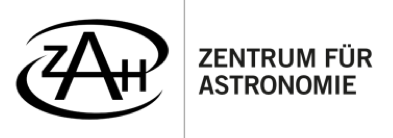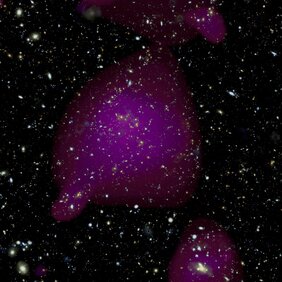Astronomers Unveil Deepest-Ever Census of Galaxy Groups with the COSMOS-Web Survey
New Catalog Extends Mapping of the Universe’s Structure at the onset of galaxy formation
A team of international astronomers, including Matteo Maturi from the Center for Astronomy of Heidelberg University (ZAH), has released a groundbreaking new catalog of galaxy groups as part of the COSMOS-Web survey, one of the largest and most ambitious imaging programs ever conducted with NASA’s James Webb Space Telescope (JWST). The study, "The COSMOS-Web Deep Galaxy Group Catalog up to z=3.7", offers an unprecedented view into the large-scale structure of the Universe as it existed more than 12 billion years ago.
Using cutting-edge imaging from JWST and deep multi-wavelength imaging data and the AMICO (Adaptive Matched Identifier of Clustered Objects) algorithm developed at Heidelberg University, the researchers identified and characterized over 1.000 galaxy groups up to a redshift of 3.7, corresponding to a time when the Universe was less than 12% of its current age. These groups represent early building blocks of cosmic structure, eventually evolving into today’s galaxy clusters.
“This is the most comprehensive catalog of its kind at these redshifts,” said Greta Toni, lead researcher from the University of Bologna. “For the first time, we are seeing the emergence of galaxy groups in the early Universe at this level of detail.”
Key Findings and their Applications
The new catalog traces galaxy associations up to a redshift of 3.7, probing the cosmic web in the early Universe farther than any previous catalog of galaxy groups. The spatial distribution of galaxy groups already reveals filamentary structures and overdensities, which are early signatures of the cosmic web, emerging just a few billion years after the Big Bang.
Group environments were shown to influence the evolution of galaxies even at these early epochs, with enhanced star formation and early morphological transformations observed among member galaxies. Overall, the new catalog data offer a critical test for cosmological models and simulations, providing real-world constraints on how matter clustered in the young Universe. Therefore, the catalog is expected to become a cornerstone resource for studying environmental effects on galaxy formation, understanding dark matter halos in the early Universe, and comparing theoretical predictions of structure formation.
“Thanks to JWST and COSMOS-Web and the AMICO algorithm we developed, we are now bridging a crucial gap in our understanding of how galaxies began organizing themselves into the cosmic web,” said Matteo Maturi, senior researcher at the Center of Astronomy of Heidelberg University (ZAH). Prof. Maturi is local expert on cosmology and on a deflection phenomenon called gravitational lensing, which allows to quantify the amount of matter in the universe and draw conclusions on how this matter is distributed in the Universe.
The full catalog is now under deep scrutiny of the COSMOS-Web collaboration to unvail further insights into galaxy and structure formation. Soon it will be made publicly available, enabling researchers to explore the environments of early galaxies in unprecedented detail.
About COSMOS-Web
COSMOS-Web is the largest extragalactic survey ever conducted with JWST, covering about 0.6 square degrees of the sky using NIRCam and MIRI instruments. Its mission is to chart the evolution of the Universe’s large-scale structure and the growth of galaxies from the first billion years to today.
ORIGINAL PUBLICATION
The COSMOS-Web deep galaxy group catalog up to z=3.7, Greta Toni, Ghassem Gozaliasl, Matteo Maturi, et. al. (https://doi.org/10.1051/0004-6361/202553759 and arxiv.org/pdf/2501.09060)
ADDITIONAL INFORMATION
Press release of Heidelberg University: https://www.uni-heidelberg.de/en/newsroom
COSMOS-Web project homepage: https://cosmos.astro.caltech.edu/page/cosmosweb
ESA picture of the month: https://esawebb.org/images/potm/
Center for Astronomy of Heidelberg University (ZAH): https://zah.uni-heidelberg.de/welcome
Research homepage of Prof. Dr. Matteo Maturi: https://www.ita.uni-heidelberg.de/%7Ematuri/projects.htm
SCIENTIFIC CONTACT
Prof. Dr. Matto Maturi
Center for Astronomy of Heidelberg University (ZAH)
Institute for Theoretical Astrophysics (ITA)
maturi@uni-heidelberg.de
CONTACT FOR THE MEDIA
Dr. Guido Thimm
Center for Astronomy of Heidelberg University (ZAH)
thimm@uni-heidelberg.de

